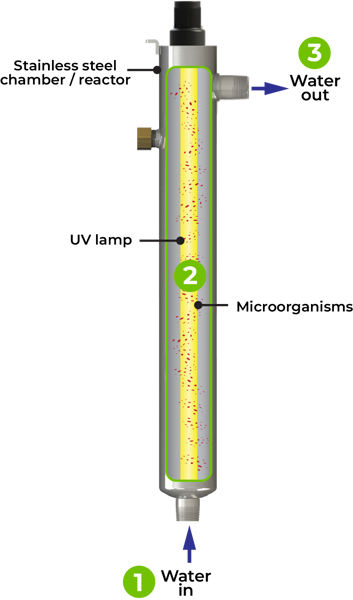Facts About Uvc Light Uncovered
Facts About Uvc Light Uncovered
Blog Article
3 Simple Techniques For Uvc Light
Table of ContentsThe Of Uvc LightThe Best Guide To Uvc LightSome Known Details About Uvc Light The 10-Second Trick For Uvc LightIndicators on Uvc Light You Should KnowGetting The Uvc Light To Work
A brand-new kind of ultraviolet light that may be risk-free for individuals took much less than five mins to minimize the degree of interior air-borne microbes by more than 98%, a joint study by researchers at Columbia University Vagelos University of Physicians and Surgeons and in the U.K. has located. Also as microorganisms continued to be sprayed right into the space, the level remained really reduced as long as the lights were on.Until now these research studies had actually just been performed in small experimental chambers, not in full-sized areas mimicking real-world problems. In the current study, scientists at the University of St. Andrews, College of Dundee, College of Leeds, and Columbia University examined the efficiency of far-UVC light in a large room-sized chamber with the very same air flow rate as a normal home or workplace (concerning 3 air adjustments per hour).
The efficiency of different methods to minimizing indoor infection levels is generally determined in regards to equal air modifications per hour. In this research study, far-UVC lights generated the equivalent of 184 equivalent air exchanges per hour. This exceeds any type of other method to sanitizing busy indoor rooms, where five to 20 equivalent air adjustments per hour is the very best that can be attained practically.
Uvc Light - The Facts

The primary specifications of UV-C sanitation are wavelength, dose, loved one moisture, and temperature level. There is no consensus about their optimum values, but, as a whole, light at a high dosage and a range of wavelengths having 260 nm is liked in a setting at space temperature level with reduced loved one moisture. This light can be generated by mercury-vapour, light-emitting diode (LED), pulsed-xenon, or excimer lights.
UV-C disinfection systems have promising features and the possible to improve in the future. UV-C disinfection should presently be considered for low-level rather than high-level disinfection.
An additional application arose in 1910 when UV light was made use of to sanitize water. Nowadays, UV light is made use of for water, air, food, surface area, and clinical tools sanitation.
Top Guidelines Of Uvc Light
DNA, RNA, or healthy proteins of a micro-organism take in UV light, with a peak absorbance around 260 nm [6] This results in the interruption of DNA or RNA, causing the inactivation of the micro-organism. UV-C-induced DNA disruption typically includes the bonding of two adjoining thymine (or cytosine) bases as opposed to the standard linking of a base with its complementary base on the various other strand.

The UV-C area is utilized for disinfection but there is no consensus on the specific ideal wavelength. Bacterial DNA and RNA have peak absorbances of light at 260265 nm and around 260 nm, respectively [6] Therefore light at 260 nm can cause one of the most disruption. Nonetheless, different micro-organisms are most at risk to somewhat various wavelengths.
Uvc Light for Beginners
On the other hand, it has technological implications given that the complete power of the light beam is then divided over all existing wavelengths. A micro-organism that is vulnerable to 254 nm light will certainly be suspended a lot more by a lamp that releases solely light at 254 nm than a light that gives off a wavelength spectrum at equivalent complete energy.
Exposure times of 1045 minutes for space sanitation and 25 s original site to 5 min for clinical equipment were come across in literature. The strength is inversely symmetrical to the made even distance between the source of light and the surface and is consequently defined at the surface in the dose calculation formula [14]
Further, the result of a lamp reduces over time, so it is recommended to calculate the dosage at the end of light life, which is rep of a worst-case scenario. The dose likewise influences the quantity of photoreactivation.
Zhang et al. observed a change in UV irradiance of 34% when the RH increased from 50% to 90% [18] The quantity of RH impact on UV performance depends upon the existing micro-organism and is extra apparent for bacteria than for infections [16] Lastly, the impact of temperature level relies on the light.
See This Report about Uvc Light


This is known as much UV-C technology and is a reasonably brand-new sanitation approach with minimal expertise concerning its performance.
In research study, the results on pulsed versus constant UV-C sanitation efficiency vary. When contrasting pulsed and continual light it is essential to maintain various other variables such as wavelength and dose continuous. Nyangaresi et al. and Sholtes et al. both located that pulsed or continual light discharged by LEDs about his caused equivalent log10 reductions [15,28]
Our Uvc Light Ideas
In situation ozone is not needed for sanitation, a click here for info changed light can be made use of. For mercury-vapour lights, doped quartz glass or specialized soft glass can filter out short-wave UV-C light - uvc light.
Report this page